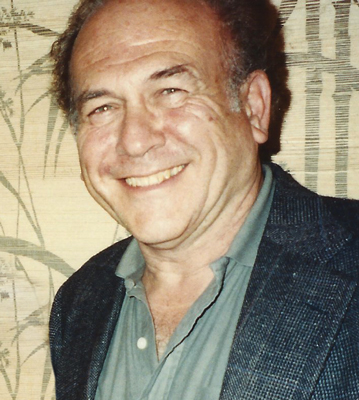George Gidal, a distinguished experimental particle physicist and longtime scientist in the Physics Division of Lawrence Berkeley National Laboratory, died of pneumonia March 1st in Berkeley. He was 78.
Born in Munich, Germany, in 1934, Gidal grew up in Brooklyn, NY. He attended James Madison High School, where he was a proud member of the math team that, on occasion, was able to beat Bronx Science and Brooklyn Tech. He received his B.A. from Columbia University in 1955, and went on to earn his M.A. in 1957 and his Ph.D. in 1960, where his thesis advisor, Leon Lederman, had put him to work studying muons, not yet understood to be the more massive cousins of the electron.
In 1961 Gidal joined Wilson Powell and Bob Birge’s group at the Lawrence Radiation Laboratory – today’s Lawrence Berkeley National Laboratory (Berkeley Lab) – where, aside from teaching and research stays in Italy, Israel, and France, he was to base his entire career. There he met Toby Aronstein, a computer programmer who developed software for the Flying Spot Digitizer that measured bubble-chamber tracks. Aronstein later became his wife.
“George came to Berkeley just a few years after the discovery of the antiproton,” says physicist Bob Cahn, who became Gidal’s friend after they met in 1979. Cahn notes that the antiproton, only the second antimatter particle to be found, had been discovered at the Bevatron in 1955, and Gidal was fascinated by the question of how some matter had survived the earliest moments after the big bang, when almost all matter and antimatter mutually annihilated.
Says Cahn, Gidal’s “earliest and latest experiments looked for CP violation,” the violation of charge/parity symmetry, whose actual, if slight, asymmetry was Andrei Sakharov’s theoretical explanation for the predominance of matter. Says Cahn, “For over 50 years, George was exploring not just subatomic phenomena but the great mysteries of nature.”
Beginning in the 1970s, much of Gidal’s experimentation and that of other Berkeley Lab physicists made use of accelerators at SLAC and elsewhere that created copious amounts of antimatter. At SLAC in the 1970s, electrons and positrons (antielectrons) were collided first in the SPEAR ring and later at the SLAC Linear Collider and the PEP collider. Gidal’s work there included numerous studies of short-lived particles and their interactions in the debris of these matter-antimatter collisions; Gidal also became involved in colliding beams of high-energy photons.
At the end of the 1970s, Gidal found himself deeply involved in another kind of undertaking, a campaign to help dissident scientists Yuri Orlov and Natan Sharansky in the Soviet Union, founded by his Berkeley Lab colleagues Morris Pripstein and Denis Keefe. Gidal, Cahn, Gerson Goldhaber, and the Lab’s then-director, Andy Sessler, were among a number of Berkeley Lab scientists who were the first members of Scientists for Orlov and Sharansky (SOS), which was soon enlarged to support the outspoken Sakharov as well. SOS proved highly effective and eventually resulted in the release of all three from internal exile.
From 1980 to 1985, Gidal was a core participant in a group including Herbert Steiner, Mark Strovink, and Robert Tripp, who used a muon beam from the TRIUMF cyclotron in Vancouver to investigate whether the symmetry of the W boson, the charged carrier of the weak force, is strictly left-handed. They set a stringent lower limit on the mass of a right-handed W boson not surpassed until the 1990s, when, if this hypothetical particle existed, Fermilab’s Tevatron would have produced it directly.
Later in the 1980s Gidal worked with Goldhaber and George Trilling at the Mark II experiment at SLAC, measuring the lifetime of the tau lepton and other particles. In 1988 he was elected a Fellow of the American Physical Society and cited “for his significant experimental contributions to the physics of weak interactions, meson nucleon inelastic scattering, and photon-photon interactions.” By the end of the decade, Gidal was engrossed in studies of the massive Z boson, the W’s neutral partner as carrier of the weak force, including the prospect that energetic Z bosons might even include the Higgs boson among their decay products.
Beginning in the early 1990s, Gidal participated in experiments at Fermilab, one of which, designated E789, focused partly on producing massive bottom quarks by slamming protons into a fixed target. His colleague Kam-Biu Luk, who had recently joined Berkeley Lab from Fermilab, says Gidal “pioneered the technique for studying bottom mesons,” evanescent particles briefly formed when bottom quarks join, either as ordinary matter or antimatter, with another quark. “George played an active role in data analysis, which led to the first determination of the production cross-section of bottom hadrons in proton collisions” – the likelihood of finding particles that included a bottom quark in those collisions.
Gidal officially retired from Berkeley Lab in 1999 but carried on his research at Fermilab until 2004. Says Luk, “He was one of the founding members of the HyperCP experiment,” another fixed-target experiment that searched for CP violation in the decay of hyperons, particles containing strange quarks. It was a search, Luk says, conducted “with the best sensitivity in the world.” Luk remembers Gidal as “a devoted physicist and a fantastic colleague who was always willing to help.”
Says Cahn, “George’s career spanned most of the discoveries that gave us a nearly complete picture of fundamental interactions and was an important participant in many of these discoveries…. George Gidal showed that you could pursue nature’s secrets while remaining a good, kind, and gentle person. We shall miss him greatly.”
Gidal is survived by his wife, Toby, his sons Eric and Marc, their wives, Jackie and Jessica, and five grandchildren, Lottie, Sylvia, Jennie, Noa, and Max Gidal.
